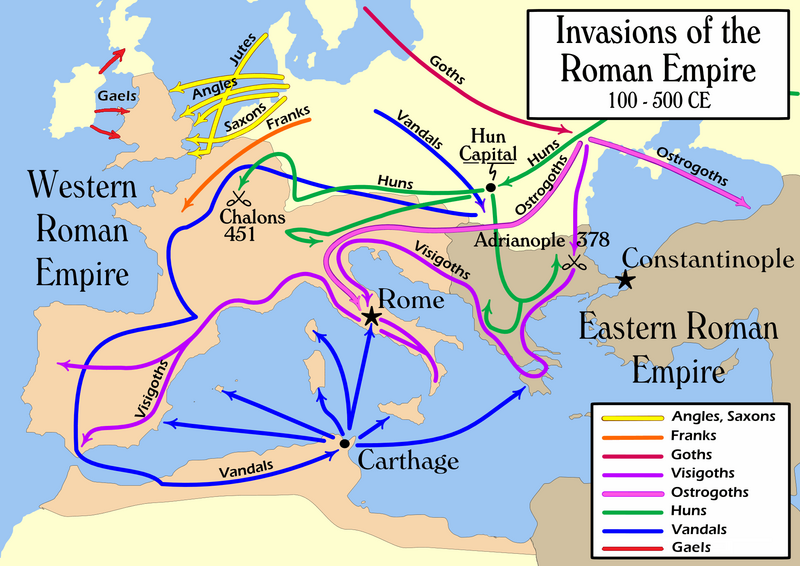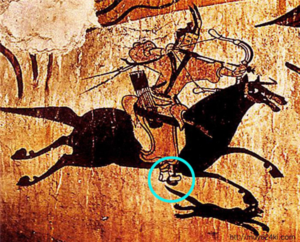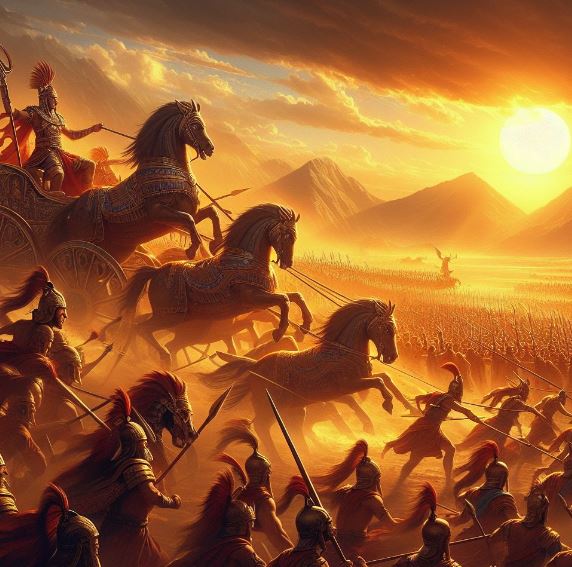In 1286 BC, Egyptian Pharaoh Ramses II set out on a campaign to the north. His destination was Kadesh, located in present-day Syria, where the borders of the Egyptian and Hittite empires met. The Battle of Kadesh is noted in history as the oldest recorded battle. A distinctive feature of this battle was the major clash involving chariot forces. If this war were made into a movie, it could depict the grand spectacle of the largest-scale chariot battle ever. Both sides primarily utilized chariots as their main force.
For this battle, the Hittites were armed with 3,500 chariots and the Egyptians with 2,500, totaling 6,000 chariots engaged in combat. Each Hittite chariot was manned by a driver, a shooter, and a combat soldier, while each Egyptian chariot carried two people. The winner of the battle remains uncertain. Egyptian records claim a victory, but Hittite records and other documents discovered later suggest that the Hittites had the upper hand. Regardless, this battle concluded with the earliest recorded peace treaty between nations.

Why were there horses in this battle, but no cavalry? In fact, proper cavalry did not exist in this region or even in China until the Warring States period. It wasn’t that people didn’t ride horses, but that they couldn’t effectively fight while mounted. The reason for this was the absence of saddles and stirrups in history at that time.
Stirrups are devices that help a rider maintain stability while mounting or riding a horse. They are attached to the saddle and hang on either side to allow the rider’s feet to rest in them. Although simple, the use of stirrups allowed cavalry to stand on both feet while riding, enabling them to shoot arrows or wield swords and spears from a more stable posture. Under the same conditions, they could also wear heavier armor and wield heavier weapons.
Therefore, in ancient times such as in Egypt or Rome, movies set in these eras only show chariots. Even during the Spring and Autumn period in China, chariots were the main military force. However, chariots had limitations; they could only run on flat terrain and were slow.
Proper cavalry appeared in this region only after the Assyrians began using saddles. Even though saddles were used, the absence of stirrups meant that the cavalry, although called so, only consisted of lightly armed spearmen. Nevertheless, the Assyrian cavalry was so powerful for a while that there were no nearby enemies. With the addition of cavalry, Assyria was able to create a new combination of infantry and chariot forces, which allowed them to defeat the powerful Hittite empire and grow into an empire themselves.
Later, for over a thousand years, there were no significant advancements in warfare or tactics in the region until new players equipped with stirrups changed the paradigm of war. These new players in the regional league were none other than the Germanic and Hunnic tribes. Around AD 375, the Huns, a nomadic people of Asian origin living northeast of the Caspian Sea, moved westward, pressuring the East Goths(Ostrogoths) along the Black Sea coast, which led to the mass migration of the Germanic tribes across the Danube into Roman territory, lasting for about 200 years.

In August 378 AD, to counter the invasion of the Roman Empire by Germanic tribes, Emperor Valens of the Eastern Roman Empire mobilized 40,000 troops from seven Roman legions. Their opponents were 50,000 Goths, who were being pushed by the pressure of the Huns. These Germanic tribes clashed with the Romans at Adrianople, a strategic passageway in Asia Minor and the Balkans. As mentioned, the core of the Greek-Roman legions was the closely formed infantry. The basic tactic involved lightly armed cavalry exploiting mobility to target enemy vulnerabilities. Compared to the well-organized Roman military, the Gothic army, though numerically superior, was not a well-trained elite force. Consider that these were part of the Germanic tribes being pushed westward by the Huns.
The result was a catastrophic defeat for the Roman army. Without stirrups, Roman cavalry had to hold the reins with one hand to stay mounted, making them significantly less effective than the heavily armed Gothic cavalry who, equipped with stirrups, could use both hands in combat. This explains why Roman soldiers, unlike the figures depicted in the murals of Korea’s Muyong Tomb, could not shoot bows with both hands while riding. The well-equipped Gothic cavalry overpowered the Roman flanking forces and surrounded the entire Roman legion. Emperor Valens and his 40,000 troops were completely destroyed. Rome’s heavily armored infantry, previously considered invincible since ancient Greece, proved ineffective against the mounted cavalry. The devastating loss at Adrianople triggered a massive influx of Germanic tribes into Roman territories, ultimately leading to the decline and eventual fall of the Western Roman Empire.

https://www.inews365.com/news/article.html?no=334896
The Goths first encountered stirrups around 300 AD during the Hunnic invasion. Having suffered severely at the hands of Hunnic cavalry, the Goths adopted stirrups and trained their cavalry, which successfully defeated Rome’s elite infantry.
Stand Out with a Unique Umbrella
While all humans share a common conscience and foundational similarities, each individual possesses unique characteristics. Even minor differences are significant, influencing transactions and enhancing collaborative efforts through specialized roles. People may be similar, yet they also differ in distinct ways—just as each person has unique facial features and fingerprints, so too do their preferences and skills vary. This natural diversity leads to differentiation, which is increasingly recognized as a crucial strategy for personal success. As American poet and minister Ralph Waldo Emerson once expressed: If a man can write a better book, preach a better sermon or make a better mouse trap than his neighbors, though he builds his house in the woods, the world will make a beaten path to his door.
“Build a better mousetrap, and the world will beat a path to your door”
Where should one find points of differentiation? Typically, these are found in one’s environment and the areas where one can excel. Greece and Rome included mountainous terrain, which led to the development of closely formed infantry as a core military strength. In contrast, the ancient states in the Persian region, with their extensive experience in plains warfare, made chariots their primary weapon. Meanwhile, nomadic tribes living on the Eurasian steppes had long been accustomed to horseback living. It is perhaps no surprise that stirrups originated with them. The prototype for stirrups is said to have been the triangular leather straps used by the Scythians of the Central Asian steppes. These stirrups gradually improved and came into widespread use among nomadic tribes.
People often emphasize, “Do what makes you happy.” It’s hard to beat someone who enjoys their work. It’s generally believed that people who make a career out of what they love are more likely to succeed and be happy. Enjoying your work leads to proficiency, and being good at it makes you enjoy it even more, earning recognition and income along the way. It’s a wonderful life.
But how many people are fortunate enough to enjoy such luck? It does not seem easy for nomads from Mongolia, who excel at and enjoy horse riding, to dominate today’s global market. The reality is that those who succeed by doing what they are good at are a minority. It’s important to remember the many more who fail. For this reason, some argue, “If you want to succeed, you should compete in what you are good at, not necessarily what you like.” If you excel at and enjoy the same thing, you are truly fortunate. Conversely, the most unfortunate people are those who neither excel at nor enjoy their work. However, it is crucial that one’s proficiency be measured not just by personal belief but in comparison to others, as market selection plays a role.
People refer to the ability to work as intelligence. In other words, intelligence is knowing how to do something—what we call know-how. On the other hand, having extensive theoretical knowledge is commonly referred to as having a lot of knowledge. However, just as personalities vary, so do these abilities. Innate or latent abilities are called talent. Talent originally refers to the natural aptitude and capability to perform tasks, encompassing both inherent abilities and skills acquired through training, though it typically refers to innate aptitude.
“Talent wins games, but teamwork and intelligence win championships.”
The issue is that having talent does not necessarily translate to intelligence. This is why educators consistently emphasize the importance of developing one’s natural abilities, believing that these abilities can evolve into talent and then transform into intelligence, thus becoming competitive. However, for talent to be competitive, it must, like a core competency in a business, create value and be distinctively differentiated. Such talent has the potential for expansion and is not easily replicated by others. Expansiveness means having the ability to be competitive across various fields.
The knowledge concerning personal development is specifically referred to as the study of success. Although it is not established as a formal discipline, it applies various academic principles to topics like self-improvement and interpersonal relationships. Therefore, the strategy for enhancing an individual’s competitiveness can also be considered differentiation. However, differentiation is not simply being different from others; it involves possessing core competencies that can produce value demanded by society and the market. And these core competencies begin with one’s own talents. Ultimately, it means that one should engage in work they enjoy and are naturally good at, using their strengths and talents where they are most applicable. This application of abilities to preferred activities is the differentiation strategy of success studies.
Moreover, for these core competencies to endure, continuous knowledge acquisition and training are necessary. Talents or natural abilities might not always be immediately apparent; they can become visible through learning and experience. Conversely, core competencies are not limited to a single field but can be applicable across many areas. Moreover, new fields are constantly emerging, aren’t they? There might not always be a market for what one loves to do. In such cases, one might need to create their own opportunities.


답글 남기기